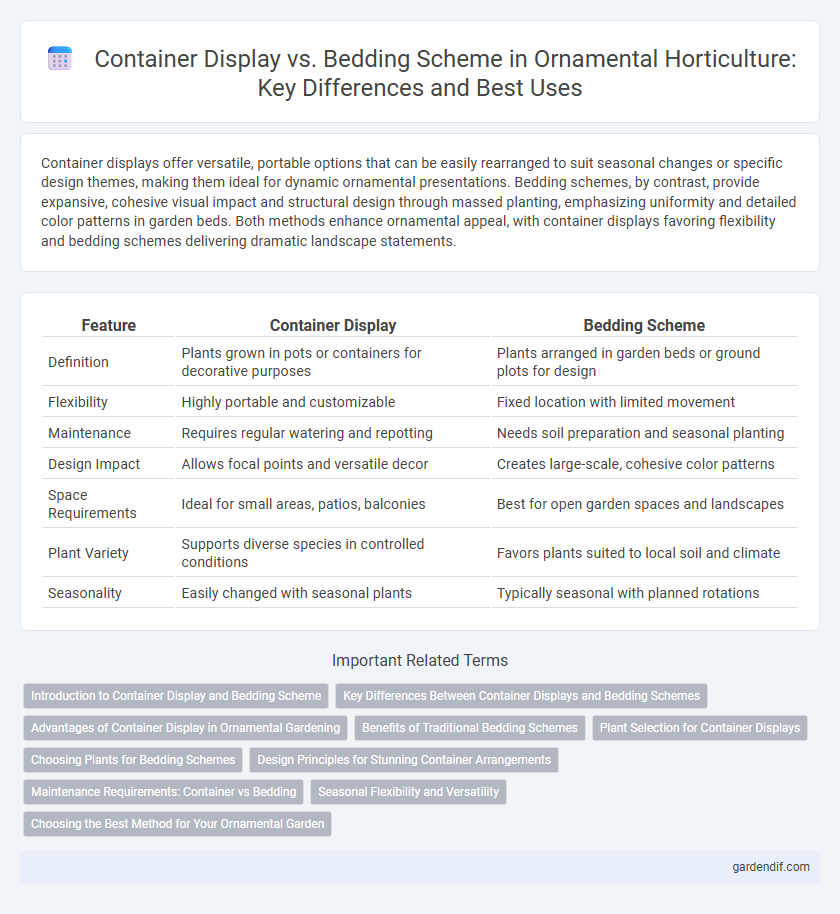
Container Display vs Bedding Scheme Illustration
Container displays offer versatile, portable options that can be easily rearranged to suit seasonal changes or specific design themes, making them ideal for dynamic ornamental presentations. Bedding schemes, by contrast, provide expansive, cohesive visual impact and structural design through massed planting, emphasizing uniformity and detailed color patterns in garden beds. Both methods enhance ornamental appeal, with container displays favoring flexibility and bedding schemes delivering dramatic landscape statements.
Table of Comparison
| Feature | Container Display | Bedding Scheme |
|---|---|---|
| Definition | Plants grown in pots or containers for decorative purposes | Plants arranged in garden beds or ground plots for design |
| Flexibility | Highly portable and customizable | Fixed location with limited movement |
| Maintenance | Requires regular watering and repotting | Needs soil preparation and seasonal planting |
| Design Impact | Allows focal points and versatile decor | Creates large-scale, cohesive color patterns |
| Space Requirements | Ideal for small areas, patios, balconies | Best for open garden spaces and landscapes |
| Plant Variety | Supports diverse species in controlled conditions | Favors plants suited to local soil and climate |
| Seasonality | Easily changed with seasonal plants | Typically seasonal with planned rotations |
Introduction to Container Display and Bedding Scheme
Container displays utilize portable pots or planters to showcase ornamental plants, offering versatile placement and seasonal adaptability. Bedding schemes involve fixed, ground-level arrangements designed to create cohesive color patterns and textures within garden beds. Both methods enhance landscape aesthetics but differ in flexibility and design scale.
Key Differences Between Container Displays and Bedding Schemes
Container displays offer flexibility with mobility and seasonal variety, allowing for personalized arrangements in limited spaces, whereas bedding schemes provide large-scale plantings designed for visual impact in permanent garden beds. Container displays often feature a mix of textures and colors in compact formats, while bedding schemes emphasize uniform patterns and mass plantings to create cohesive landscape designs. Maintenance requirements differ as containers need more frequent watering and care, compared to the relatively stable conditions of established bedding schemes.
Advantages of Container Display in Ornamental Gardening
Container displays in ornamental gardening offer superior flexibility, allowing easy relocation and seasonal changes without disturbing plant roots. They enable precise control over soil quality, moisture levels, and nutrient management, optimizing plant health and ornamental value. Containers also reduce weed growth and pest intrusion, enhancing maintenance efficiency and overall garden aesthetics.
Benefits of Traditional Bedding Schemes
Traditional bedding schemes offer vibrant, seasonal color changes that enhance garden aesthetics and create dynamic visual interest. These schemes utilize a diverse range of plant species that thrive in specific climates, promoting biodiversity and long-term sustainability. Their structured layouts facilitate easy maintenance and allow for seamless integration with existing landscape designs.
Plant Selection for Container Displays
Selecting plants for container displays requires choosing species with compact root systems and tolerance for confined soil volumes, such as succulents, annuals like petunias, and dwarf shrubs. These plants thrive in limited space and offer vibrant, adaptable aesthetics, making them ideal for container versatility. In contrast to bedding schemes that allow extensive root growth and mass planting, container displays benefit from drought-resistant and fast-growing varieties to maintain health and visual appeal.
Choosing Plants for Bedding Schemes
Selecting plants for bedding schemes requires consideration of growth habits, blooming periods, and color coordination to create vibrant, long-lasting displays. Compact, fast-growing species with consistent flowering cycles such as begonias, petunias, and marigolds are ideal for maximizing visual impact in bedding schemes compared to container displays. Emphasizing uniformity and seasonal succession enhances the overall aesthetic appeal and horticultural performance in ornamental bedding arrangements.
Design Principles for Stunning Container Arrangements
Stunning container arrangements rely on design principles such as balance, color harmony, and texture contrast to create visual appeal. Container displays offer flexibility in height and mobility, allowing for dynamic layering and repositioning that enhance focal points. Bedding schemes require careful planning of plant selection and spatial layout to achieve uniformity and seasonal interest, but container designs prioritize versatility and individualized expression.
Maintenance Requirements: Container vs Bedding
Container displays demand more frequent watering and regular fertilization due to limited soil volume, while bedding schemes benefit from deeper soil profiles that retain moisture longer, reducing irrigation frequency. Containers often require seasonal replacement or pruning to maintain plant health, whereas bedding plants can be more resilient but need periodic soil amendment and pest control. Both methods require tailored maintenance strategies, but containers generally involve higher ongoing care for optimal ornamental appeal.
Seasonal Flexibility and Versatility
Container displays offer superior seasonal flexibility by allowing quick plant swaps to match changing climates and holidays, whereas bedding schemes require extensive labor for replanting entire garden beds. Containers support diverse plant varieties and designs year-round, enhancing versatility for small spaces and patios. Bedding schemes excel in large-scale, uniform aesthetics but lack the adaptability and convenience containers provide for dynamic seasonal transitions.
Choosing the Best Method for Your Ornamental Garden
Container displays offer versatility and mobility, allowing gardeners to customize and reposition ornamental plants to enhance seasonal interest and cope with varying sunlight conditions. Bedding schemes provide a more permanent, cohesive design that emphasizes mass planting and color patterns to create a visually impactful garden layout. Selecting the best method depends on factors like space availability, maintenance preferences, climate adaptability, and the desired level of design flexibility.
Container Display vs Bedding Scheme Infographic

 gardendif.com
gardendif.com